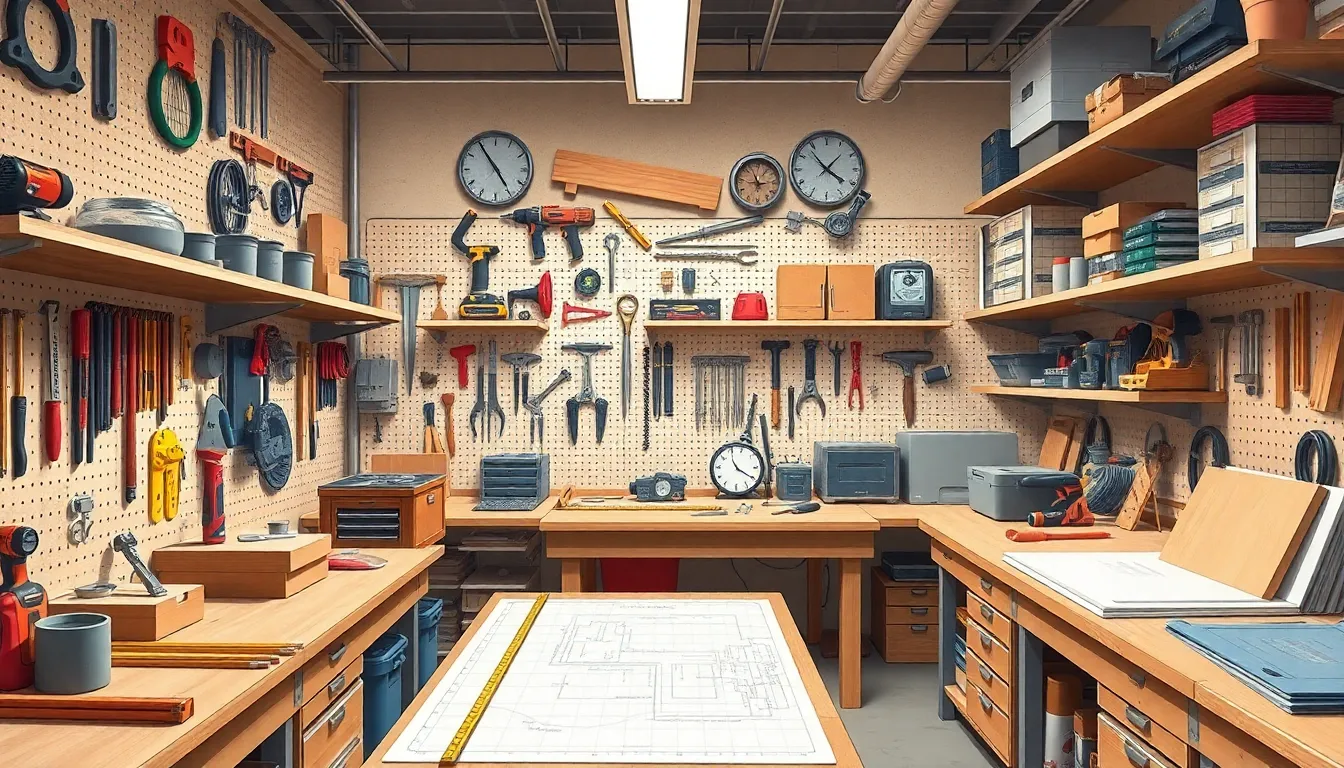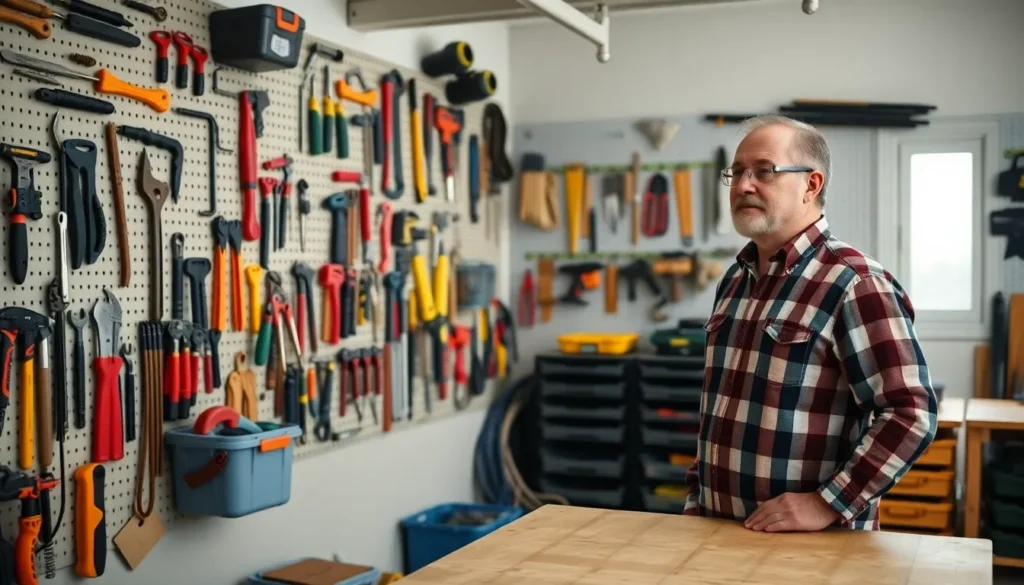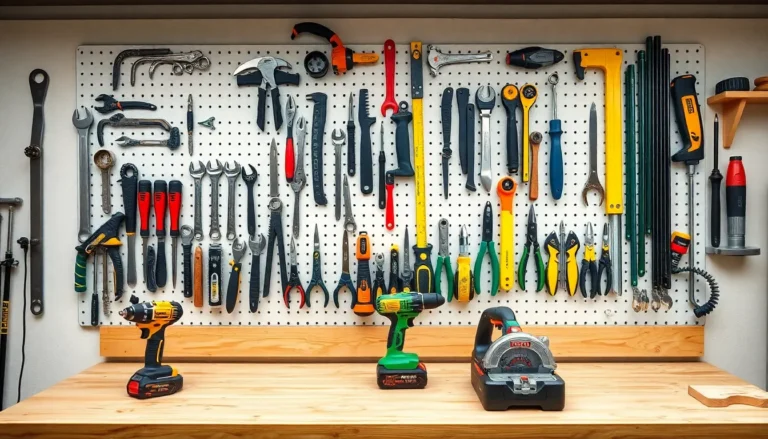A cluttered workshop can feel like a chaotic circus where tools perform acrobatics just to hide from you. If you’ve ever spent an eternity searching for that elusive wrench or tripped over a rogue hammer, you know the struggle is real. Organizing tools isn’t just about tidiness; it’s about reclaiming your sanity and unlocking your inner craftsman.
Table of Contents
ToggleImportance Of Organizing Tools
Organizing tools in a workshop saves time during projects. It streamlines workflows and enhances efficiency. A well-structured space reduces the frustration of searching for misplaced items. Craftsmanship improves when tools are readily accessible.
Space utilization becomes more effective with designated areas for different tools. For example, hanging tools on walls or using labeled storage containers minimizes clutter. This system promotes safety by preventing accidents caused by scattered equipment.
Making tools visible encourages proper maintenance and care. Regularly inspecting tools prevents wear and extends their lifespan. Furthermore, an organized workshop fosters creativity by creating an inspiring environment.
Collaboration benefits when multiple users can easily locate tools. Team projects progress faster when everyone knows where to find necessary equipment. Ultimately, prioritizing organization leads to better results and satisfaction in craftsmanship.
Studies show that a tidy workspace can increase productivity by over 25%. Following best practices for tool organization enhances overall workshop performance. Implementing storage solutions ensures everything has its place, creating a coherent working environment.
Assessing Your Workshop Space

Assessing the workshop space lays the foundation for effective organization. Understanding its dimensions and layout is crucial for maximizing efficiency.
Measuring Your Area
Begin by measuring the length and width of the workshop area. Consider the height to identify vertical storage opportunities. Tools, equipment, and work surfaces require adequate spacing for safe use. Recording precise measurements assists in planning where to place storage units, tables, and pegboards. Using a layout drawing facilitates visualizing the best configurations for tool organization. Measuring aids in determining the amount of shelving or cabinetry necessary for effective storage.
Identifying Your Needs
Identifying specific tool requirements enhances organization. Consider which tools are used most often for various projects. Keeping frequently used items within arm’s reach minimizes time spent searching for them. Organizing by categories, such as hand tools, power tools, and accessories, simplifies access. Addressing any additional needs, such as safety gear or materials, optimizes the workspace. Understanding needs encourages thoughtful purchasing decisions for new tools or storage solutions, which ultimately promotes a well-organized environment.
Choosing Storage Solutions
Selecting the right storage solutions plays a crucial role in organizing tools effectively. Various options cater to different needs and preferences, ensuring accessibility and efficiency.
Toolboxes and Chests
Toolboxes and chests provide robust storage for portable tool collections. These containers often feature multiple compartments to organize tools by type or project. A sturdy chest can withstand wear and tear, while smaller toolboxes offer portability for on-the-go projects. Stackable toolboxes maximize vertical space, allowing for easy access and reduced floor clutter. For those who prioritize organization, choosing locks or secure latches adds a layer of safety for valuable tools.
Shelving Units and Pegboards
Shelving units and pegboards optimize vertical space in workshops. Fixed shelving options accommodate larger tools and heavy equipment, keeping them off work surfaces. Adjustability allows users to customize heights based on tool sizes, creating flexibility. Pegboards, on the other hand, make frequently used tools visible and accessible, promoting quick task completion. Using hooks and bins on pegboards provides additional organization, promoting neatness and safety in the workspace.
Categorizing Your Tools
Organizing tools by category simplifies access and enhances workflow efficiency. Categorization includes segments for hand tools and power tools.
Hand Tools
Hand tools should be arranged based on use and size. Place frequently used items like hammers, screwdrivers, and pliers within reach. Drawers or portable toolboxes with labeled compartments promote easy identification and return after use. Hooks and pegboards serve as excellent options for hanging, allowing for quick visibility and access. Grouping similar tools, such as wrenches and sockets, minimizes clutter and fosters streamlined workflows. Prioritizing space for safety gear alongside hand tools ensures everything is readily available.
Power Tools
Power tools require careful organization due to their size and complexity. Designate specific areas for larger items like drills, saws, and sanders. Shelving units or sturdy cabinets can store them securely while keeping work surfaces clear. Cords should be managed with clips or reels to prevent tangling. Labeling storage helps identify tools quickly during projects. Keeping essential accessories and attachments, such as drill bits and blades, organized in separate containers enhances readiness and efficiency. Regular assessments of these categories encourage maintaining an orderly workshop environment.
Implementing a System
Implementing a systematic approach to tool organization is crucial for optimal efficiency and ease of access.
Labeling and Marking
Labeling tools and storage areas creates clarity within the workshop. Organizing items in labeled containers ensures quick identification during projects. Applying clear labels on shelves and toolboxes enhances visibility and access. Using a color-coding system can further simplify the organization process. For instance, dedicating one color for hand tools and another for power tools improves sorting efficiency. Regularly updating labels when acquiring new tools keeps the system relevant. Spending time on labeling initially saves significant effort later during projects.
Maintenance Tips
Regular maintenance of tools supports longevity and performance. Cleaning tools after each use prevents rust and damage accumulation. Additionally, inspecting tools for wear or malfunctions encourages timely repairs. Storing tools in designated areas keeps them from becoming damaged or misplaced. Creating a maintenance schedule, such as quarterly checks, promotes proactive care. Engaging in organized upkeep underscores the importance of a tidy workspace, boosting safety and functionality. Prioritizing these practices fosters an efficient workshop, aligning with studies that suggest a tidy environment enhances productivity.
Organizing tools in a workshop transforms chaos into clarity. By implementing effective storage solutions and categorizing tools, individuals can enhance their productivity and craftsmanship. A well-structured space not only minimizes clutter but also fosters creativity and collaboration. Regular assessments and maintenance ensure that the organization system remains functional and effective over time. Ultimately, prioritizing tool organization leads to a more efficient workspace, allowing for smoother project execution and greater satisfaction in the craft. Embracing these practices can make a significant difference in any workshop environment.






